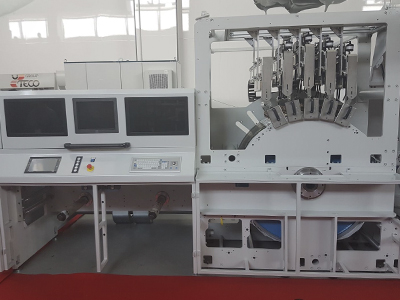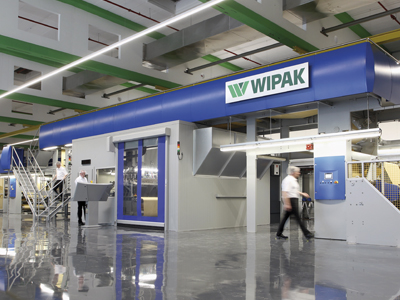Wipak launched its ProDirect printer in May
There is no holding back the march of digital inkjet print technology and more press manufacturers are now taking aim at the flexible packaging sector. By Neel Madsen.
The challenges posed by filmic substrates have held back the broader adoption of digital print technology for some time, but there are new and exciting developments coming to market that address concerns in food packaging and relating to sustainability.
One of the main barriers to entry when it comes to printing flexible packaging is food safety. While filmic materials are used for many types of packaging, by far the largest market is in food packaging. The legislation concerning contact with foodstuff demands that no particles from the ink migrate into the contents which makes UV inkjet a challenge.
Making it safe
A new collaboration this year has seen Italian press manufacturer Uteco Converting join forces with INX International and curing specialist ebeam Technologies to address this market. The three have come together to present a food packaging production line centred around electron beam inks and curing, which because it is photoinitiator-free is safe for indirect food contact. This was shown to the press at an event in Verona recently and will also be making its debut at Labelexpo in Brussels.

Uteco unveiled the Gaia press at an event in Verona in July
Taking the Greek name for Mother Earth, the Gaia press has been built using Uteco’s web handling experience and includes corona treatment and a chiller drum for printing heat-sensitive filmic substrates. The entry-level model shown prints in four colours in a resolution up to 720 x 360dpi using Xaar printheads with eight greyscales, but the companies are planning to increase the colour gamut by adding orange, green and violet to the mix.
The press prints with inkjet ebeam-curable inks from INX Digital cured with an ebeam Compact lamp, but can use UV or water-based inks from any manufacturer depending on the application. The print speed is up to 25m/min and the web width is 350mm; future developments will see a 1200 x 1200dpi version that will run at 100m/min in a wider web width. Inline converting units for hybrid production can also be added to the pressline.
‘Gaia is all about innovation and the combined technical expertise from Uteco, ebeam and INX,’ said Davide Cucinella, CMO of Uteco. ‘In addition to opening up a whole breadth of possibilities for packaging converters and label printers, it offers a new business model for digital printing – no click charge and the user is free to choose which ever supplier they want.’
Stefano Rogora, sales and marketing manager, INX Digital International, commented, ‘In Uteco and ebeam Technologies, we have found partners that embody our desire to bring to market an innovative print customisation solution, without any compromise in quality.’ He continued, ‘Packaging converters are going to be amazed at the output quality. Durable, vibrant colour with the possibility of each package or label being a one-off. Market testing will never be the same.’
‘At ebeam, we believe true technological innovation can only be achieved through collaboration, and Gaia is the latest proof point of this. In helping bring this new digital narrow web solution to market, we believe the sky is the limit for package designers and brand owners when it comes to the exciting and differentiating world of personalisation and variable printing,’ concluded Elsa Callini, business development manager at ebeam Technologies.
Uteco is also working with Kodak to bring to market the Sapphire EVO hybrid press. The 650mm wide press incorporates Kodak S-series Prosper printheads, which use water-based inks that are certified to conform to the Nestlé guidelines for food to prints at high speeds. It was first shown at drupa last year as a technology demonstration and is set for official launch later this year.
Green packaging
Also targeting food packaging, the Wipak Group launched its new ProDirect digital concept at Interpack in Düsseldorf last May. The global packaging supplier has developed its own answer to demands from brand owners for more agility, shorter runs and faster deliveries as well as sustainability. The digital wide web press uses water-based inks printing on paper laminates produced with solvent-free adhesives and the concept is completed by a web-to-print portal for direct customer orders.
‘Created for small and medium-sized print runs, ProDirect is as flexible as our customers’ markets, providing high-quality, customisable and digitally-printed wide web packaging solutions, in an efficient and sustainable manner,’ explained Wipak UK sales manager, Wayne Hallsworth. ‘Thanks to a fully automated system and a dedicated WebCenter, customers can quickly and easily approve designs and order the quantities they really need, with short delivery times and no minimum quantities, which reduces inventory, waste and write-off costs.’
He continued, ‘ProDirect print images can also be individually personalised, which is of particular benefit to manufacturers offering a large range of products and regional brands in different markets. Using the ProDirect technology it is possible to quickly respond to trends, customer requirements and competitors by efficiently and sustainably producing smaller batch sizes, such as those required for seasonal or promotional items.’
The sustainability aspect is central. Wipak’s new technology promises to help reduce carbon emissions both in the production process and the product itself. Its Walsrode site in Germany has been assessed by ClimatePartner to calculate the corporate carbon footprint, and all direct carbon emissions are offset by supporting a forest protection project in Papua New Guinea. The company also offers customers the option to track their products’ carbon footprint and choose their own climate protection projects from ClimatePartner, so they can ensure they produce a climate-neutral package.
‘Digitisation has become a real buzzword in the packaging market,’ said Patrick Verhelst, sales and marketing director. ‘We believe our concept will boost this trend and set new industry standards, putting an end to traditional business models and providing more flexible, efficient and sustainable processes for our customers.’
He concluded, ‘The launch of ProDirect comes at a time when markets are subject to massive upheavals, where things like shorter packaging cycles, custom prints, carbon-neutral packages and efficient use of resources are gaining increasing focus.’
More in the pipeline
While developments in inkjet presses for flexible packaging have increased over the past couple of years, most are still at the development stage.
Fujifilm presented the MJP20W EUCON UV inkjet press at drupa 2016. Developed for the Japanese market, it is based on collaboration with Miyakoshi. The press utilises ‘Enhanced Under Coating and Nitrogen purging’ (=EUCON) technology to reduce UV ink odour, printing on 12-100 micron PET, 25 micron OPP and 15 micron nylon, using UV LED curing at speeds up to 50m/min.
It was also at drupa we first saw the Xerox Production Press for Plastic Films and Substrates, which is a further development of the CiPress production inkjet system. The web-fed machine offers a resolution of up to 600 x 600dpi at a print speed 30m/min in CMYK. It can print with solvent, aqueous and UV inks on a wide variety of substrates.
And of course, Landa’s W10 Nanographic press is still on the horizon, promising eye-watering speeds of up to 200m/min printing in four to eight colours at 1200dpi resolution, so this is an exciting space with much more to come.
Read the full September/October issue of Digital Labels & Packaging here. Subscribe to the magazine for free – register your details here.






